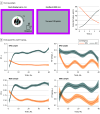Exploration-Exploitation and Suicidal Behavior in Borderline Personality Disorder and Depression
- PMID: 38985462
- PMCID: PMC11238070
- DOI: 10.1001/jamapsychiatry.2024.1796
Exploration-Exploitation and Suicidal Behavior in Borderline Personality Disorder and Depression
Erratum in
-
Error in Funding.JAMA Psychiatry. 2025 Apr 1;82(4):427. doi: 10.1001/jamapsychiatry.2025.0003. JAMA Psychiatry. 2025. PMID: 39937505 Free PMC article. No abstract available.
Abstract
Importance: Clinical theory and behavioral studies suggest that people experiencing suicidal crisis are often unable to find constructive solutions or incorporate useful information into their decisions, resulting in premature convergence on suicide and neglect of better alternatives. However, prior studies of suicidal behavior have not formally examined how individuals resolve the tradeoffs between exploiting familiar options and exploring potentially superior alternatives.
Objective: To investigate exploration and exploitation in suicidal behavior from the formal perspective of reinforcement learning.
Design, setting, and participants: Two case-control behavioral studies of exploration-exploitation of a large 1-dimensional continuous space and a 21-day prospective ambulatory study of suicidal ideation were conducted between April 2016 and March 2022. Participants were recruited from inpatient psychiatric units, outpatient clinics, and the community in Pittsburgh, Pennsylvania, and underwent laboratory and ambulatory assessments. Adults diagnosed with borderline personality disorder (BPD) and midlife and late-life major depressive disorder (MDD) were included, with each sample including demographically equated groups with a history of high-lethality suicide attempts, low-lethality suicide attempts, individuals with BPD or MDD but no suicide attempts, and control individuals without psychiatric disorders. The MDD sample also included a subgroup with serious suicidal ideation.
Main outcomes and measures: Behavioral (model-free and model-derived) indices of exploration and exploitation, suicide attempt lethality (Beck Lethality Scale), and prospectively assessed suicidal ideation.
Results: The BPD group included 171 adults (mean [SD] age, 30.55 [9.13] years; 135 [79%] female). The MDD group included 143 adults (mean [SD] age, 62.03 [6.82] years; 81 [57%] female). Across the BPD (χ23 = 50.68; P < .001) and MDD (χ24 = 36.34; P < .001) samples, individuals with high-lethality suicide attempts discovered fewer options than other groups as they were unable to shift away from unrewarded options. In contrast, those with low-lethality attempts were prone to excessive behavioral shifts after rewarded and unrewarded actions. No differences were seen in strategic early exploration or in exploitation. Among 84 participants with BPD in the ambulatory study, 56 reported suicidal ideation. Underexploration also predicted incident suicidal ideation (χ21 = 30.16; P < .001), validating the case-control results prospectively. The findings were robust to confounds, including medication exposure, affective state, and behavioral heterogeneity.
Conclusions and relevance: The findings suggest that narrow exploration and inability to abandon inferior options are associated with serious suicidal behavior and chronic suicidal thoughts. By contrast, individuals in this study who engaged in low-lethality suicidal behavior displayed a low threshold for taking potentially disadvantageous actions.
Conflict of interest statement
Figures



Similar articles
-
A Digital Therapeutic Intervention for Inpatients With Elevated Suicide Risk: A Randomized Clinical Trial.JAMA Netw Open. 2025 Aug 1;8(8):e2525809. doi: 10.1001/jamanetworkopen.2025.25809. JAMA Netw Open. 2025. PMID: 40779267 Free PMC article. Clinical Trial.
-
Crisis interventions for adults with borderline personality disorder.Cochrane Database Syst Rev. 2022 Sep 26;9(9):CD009353. doi: 10.1002/14651858.CD009353.pub3. Cochrane Database Syst Rev. 2022. PMID: 36161394 Free PMC article.
-
Prevention of self-harm and suicide in young people up to the age of 25 in education settings.Cochrane Database Syst Rev. 2024 Dec 20;12(12):CD013844. doi: 10.1002/14651858.CD013844.pub2. Cochrane Database Syst Rev. 2024. PMID: 39704320
-
New generation antidepressants for depression in children and adolescents: a network meta-analysis.Cochrane Database Syst Rev. 2021 May 24;5(5):CD013674. doi: 10.1002/14651858.CD013674.pub2. Cochrane Database Syst Rev. 2021. PMID: 34029378 Free PMC article.
-
Pharmacological interventions for people with borderline personality disorder.Cochrane Database Syst Rev. 2022 Nov 14;11(11):CD012956. doi: 10.1002/14651858.CD012956.pub2. Cochrane Database Syst Rev. 2022. PMID: 36375174 Free PMC article.
Cited by
-
Error in Funding.JAMA Psychiatry. 2025 Apr 1;82(4):427. doi: 10.1001/jamapsychiatry.2025.0003. JAMA Psychiatry. 2025. PMID: 39937505 Free PMC article. No abstract available.
-
Review: Suicide and its relationship to aggression and impulsivity.Cogn Affect Behav Neurosci. 2025 Jun 25. doi: 10.3758/s13415-025-01321-0. Online ahead of print. Cogn Affect Behav Neurosci. 2025. PMID: 40563056 Review.
-
Prefrontal default-mode network interactions with posterior hippocampus during exploration.bioRxiv [Preprint]. 2025 Mar 13:2025.03.12.642890. doi: 10.1101/2025.03.12.642890. bioRxiv. 2025. PMID: 40161797 Free PMC article. Preprint.
References
MeSH terms
Grants and funding
LinkOut - more resources
Full Text Sources
Medical
Miscellaneous

